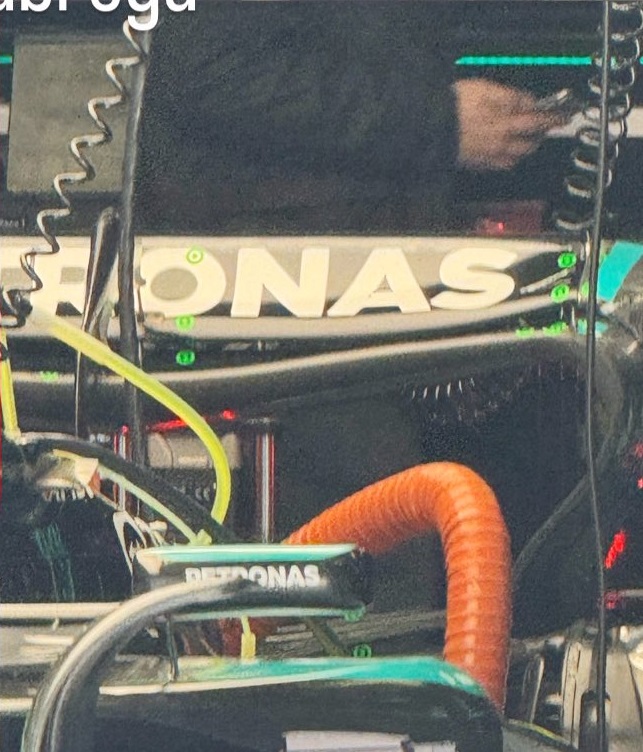
@AlbertFabrega
Compared to other team's espacially RB and Mclaren W16's engine cover looks so bulky, last year also it was very similar with no updates on that area, wonder if they will change it at all this year.Lasssept wrote: ↑04 Apr 2025, 22:53https://pbs.twimg.com/media/GnrQ-IjbIAA ... name=large
@MercedesAMGF1



I don't want to start a new focal length discussion, but the images have different perspectives, hence, the lines are not telling anything about how much flexing is going on.Vanja #66 wrote: ↑09 Apr 2025, 09:39Deeply impressive levels of rear wing flexing
https://pbs.twimg.com/media/GoE3J7YXcAA ... =4096x4096
But it's the same camera (it appears) just at different point on circuit, making that observation completely redundant.maygun wrote: ↑09 Apr 2025, 15:12I don't want to start a new focal length discussion, but the images have different perspectives, hence, the lines are not telling anything about how much flexing is going on.Vanja #66 wrote: ↑09 Apr 2025, 09:39Deeply impressive levels of rear wing flexing
https://pbs.twimg.com/media/GoE3J7YXcAA ... =4096x4096
Having the same camera doesn't mean having the same perspective to the rear wing, as depending on the bank angle, the radius of the corner and braking/speed, the rear wing and whereever the camera is mounted move differently, so you need to get rid of that difference to make a fair comparison.Farnborough wrote: ↑09 Apr 2025, 15:45But it's the same camera (it appears) just at different point on circuit, making that observation completely redundant.maygun wrote: ↑09 Apr 2025, 15:12I don't want to start a new focal length discussion, but the images have different perspectives, hence, the lines are not telling anything about how much flexing is going on.Vanja #66 wrote: ↑09 Apr 2025, 09:39Deeply impressive levels of rear wing flexing
https://pbs.twimg.com/media/GoE3J7YXcAA ... =4096x4096
Looks entirely comparative and relevant as evidence of wing movement under load.
This is describing exactly the opposite of a lens and its imaging, incorrectly in how thats applied.maygun wrote: ↑09 Apr 2025, 16:59Having the same camera doesn't mean having the same perspective to the rear wing, as depending on the bank angle, the radius of the corner and braking/speed, the rear wing and whereever the camera is mounted move differently, so you need to get rid of that difference to compare the comparison.Farnborough wrote: ↑09 Apr 2025, 15:45But it's the same camera (it appears) just at different point on circuit, making that observation completely redundant.
Looks entirely comparative and relevant as evidence of wing movement under load.
That's why they have those yellow dots, you need to track them and then apply some geometric transformations to get rid of other factors so that you can really measure how much flexing is going on.
For instance, I don't think top level of DRS actuator should flex down with the wing, but the image that shared imply that
I'm not talking about lenses or focal length—since both pictures came from the same camera, those factors are the same.Farnborough wrote: ↑09 Apr 2025, 17:45This is describing exactly the opposite of a lens and its imaging, incorrectly in how thats applied.maygun wrote: ↑09 Apr 2025, 16:59Having the same camera doesn't mean having the same perspective to the rear wing, as depending on the bank angle, the radius of the corner and braking/speed, the rear wing and whereever the camera is mounted move differently, so you need to get rid of that difference to compare the comparison.Farnborough wrote: ↑09 Apr 2025, 15:45
But it's the same camera (it appears) just at different point on circuit, making that observation completely redundant.
Looks entirely comparative and relevant as evidence of wing movement under load.
That's why they have those yellow dots, you need to track them and then apply some geometric transformations to get rid of other factors so that you can really measure how much flexing is going on.
For instance, I don't think top level of DRS actuator should flex down with the wing, but the image that shared imply that
As it comes up in forum, pertinent as that is to our discussion about fundamental aero concept and how that is working in race situation, then worthwhile clarification to help with discussion.
Lens focal length is the distance from a centre of lens design point to the imaging plane (film, sensor or other) and relates to how that particular lens is specified. It doesn't alter, at all, as it moves anywhere.
Having the lens fixed to the structure of the car (as it is here) this records, fully, any relative movement of the subject (the wing in this instance) that the lens/camera is not affixed to.
Measurements between the dots, then use of trigonometry in calculation would demonstrate how much it has moved also.
This arrangement completely illustrates the wing moving and how far it's moved in the image we see, and notes Vanja has made about it. Its a true record of the wing structure moving in relation to the car"s structure as a whole.
You're wrong, Vanja's account and observation is entirely correct.